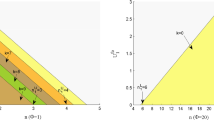Abstract
This paper studies the customers’ equilibrium and socially optimal joining–balking behavior in single-server Markovian queues with multiple working vacations. Different from the classical vacation policies, the server does not completely stop service but maintains a low service rate in vacation state in case there are customer arrivals. Based on different precision levels of the system information, we discuss the observable queues, the partially observable queues, and the unobservable queues, respectively. For each type of queues, we get both the customers’ equilibrium and socially optimal joining–balking strategies and make numerical comparisons between them. We numerically observe that their equilibrium strategy is unique, and especially, the customers’ equilibrium joining probability in vacation state is not necessarily smaller than that in busy state in the partially observable queues. Moreover, we also find that the customers’ individual behavior always deviates from the social expectation and makes the system more congested.











Similar content being viewed by others
Notes
Because of the memoryless property of the exponential distribution, both V and V R follow the same distribution.
For the observable queues, we can obviously find that the expected net benefit functions U e (i) (i=1,2) are decreasing in n so that our search for equilibrium is restricted in the class of threshold strategies.
We directly assume that n(0)≤n(1) in the transition diagram since μ v <μ b , i.e., the opposite case cannot occur.
Since we focus on the customers’ decisions from an economic viewpoint, we need to replace the arrival rate λ exists in the stationary results derived by Liu et al. (2007) with λq, who studied service systems from the classical viewpoint of queueing theory.
References
Adan I, Economou A, Kapodistria S (2009) Synchronized reneging in queueing systems with vacations. Queueing Syst 62(1):1–33
Burnetas A, Economou A (2007) Equilibrium customer strategies in a single server Markovian queue with setup times. Queueing Syst 56(3–4):213–228
Dimitrakopoulos Y, Burnetas A (2011) Customer equilibrium and optimal strategies in an M/M/1 queue with dynamic service control. Working paper, University of Athens
Economou A, Kanta S (2008) Equilibrium balking strategies in the observable single-server queue with breakdowns and repairs. Oper Res Lett 36(6):696–699
Economou A, Gómez-Corral A, Kanta S (2011) Optimal balking strategies in single-server queues with general service and vacation times. Perform Eval 68(10):967–982
Guo P, Hassin R (2011) Strategic behavior and social optimization in Markovian vacation queues. Oper Res 59(4):986–997
Guo P, Hassin R (2012) Strategic behavior and social optimization in Markovian vacation queues: the case of heterogeneous customers. Eur J Oper Res 222(2):278–286
Jagannathan K, Menache I, Modiano E, Zussman G (2011) Non-cooperative spectrum access-the dedicated vs. free spectrum choice. In: MobiHoc’11, May 16–20, 2011, Paris, France
Latouche G, Ramaswami V (1999) Introduction to matrix analysis methods in stochastic modeling, ASA-SIAM series on applied probability. SIAM, Philadelphia
Liu W, Xu X, Tian N (2007) Stochastic decompositions in the M/M/1 queue with working vacations. Oper Res Lett 35(5):595–600
Neuts M (1981) Matrix-geometric solutions in stochastic models. Johns Hopkins University Press, Baltimore
Sun W, Guo P, Tian N (2010) Equilibrium threshold strategies in observable queueing systems with setup/closedown times. Cent Eur J Oper Res 18(3):241–268
Sun W, Wang Y, Tian N (2012) Pricing and setup/closedown policies in unobservable queues with strategic customers. 4OR 10(3):287–311
Takagi H (1991) Queueing analysis—a foundation of performance evaluation. Vacation and priority systems, vol 1. North-Holland, Amsterdam
Tian N, Zhang ZG (2006) Vacation queueing models: theory and applications. Springer, New York
Tian N, Li J, Zhang ZG (2009) Matrix analysis method and working vacation queues—a survey. Int J Inf Manag Sci 20(4):603–633
Acknowledgements
The authors would like to thank the support from National Natural Science Foundation of China (No. 71101124, No. 71171174), the Natural Science Foundation of Hebei Province (No. G2012203068, No. F2013203136), the Humanity and Social Science Foundation of Ministry of Education of China (No. 12YJC790101), and the China Postdoctoral Science Foundation (No. 2012M520598).
Author information
Authors and Affiliations
Corresponding author
Rights and permissions
About this article
Cite this article
Sun, W., Li, S. Equilibrium and optimal behavior of customers in Markovian queues with multiple working vacations. TOP 22, 694–715 (2014). https://doi.org/10.1007/s11750-013-0288-6
Received:
Accepted:
Published:
Issue Date:
DOI: https://doi.org/10.1007/s11750-013-0288-6




